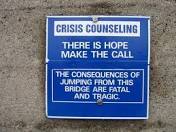Today, Sept. 10, is World Suicide Prevention Day - do something nice for someone you know is struggling
From Australia ... here are two great looking online resources and LOTS of great reference material
Alive and kicking goals! Suicide prevention project at http://www.healthinfonet.ecu.edu.au/key-resources/programs-projects?pid=1261
NACCHO Aboriginal suicide prevention: Black Dog Institute launches app to try to save lives at http://nacchocommunique.com/tag/ibobbly/
Do Not Go Gentle Into That Good Night
By Lloyd I. Sederer, MD, Medical director, New York State Office of Mental Health
Posted: 09/10/2014
Stronger Together for Suicide Prevention -- a partnership between the New York State Office of Mental Health and The Huffington Post
I know too many people who have taken their lives -- and not just because I am a psychiatrist.
These people include family members, friends, colleagues, and neighbors, as well as those in the public eye whose deaths, some very recent, have riveted our attention. While I have had the good fortune of having no patient under my direct care die by suicide, because I have led many clinical services, I have seen too many times the indelible tragedy that suicide can usher in.
Do you know someone who died by his or her hands, or tried (including perhaps you)? If you do, whether near or far from your heart, we hope you will join New York State and The Huffington Post in our campaign to help prevent deaths that need not happen. Almost everyone who survives a suicide attempt is glad to be alive. Our challenge is to figure out how to keep those people alive until they want to live again.
More than 39,000 people die each year from suicide. That is more than twice the rate in this country of homicidal deaths. One million people, annually, make a suicide attempt in the U.S. We need to think of these losses as preventable, as we already approach deaths from accidents and illnesses where prevention, early detection, and employing effective interventions are lifesaving.
Suicidal deaths are inextricably tied to mental illnesses. We estimate that in nine of every 10 completed suicides the person was suffering from an acute mental illness, clinical depression in particular. In a great many instances, the deadly action was enabled by the use of alcohol or drugs, or both, which disinhibit our protective instincts and fuel impulsiveness. What this means is that detecting and treating mental and addictive disorders will be critical to preventing suicide deaths.
Today, Sept. 10, is World Suicide Prevention Day. The World Health Organization (WHO) reports on the basis of 10 years of research from around the world that someone dies by suicide every 40 seconds. Their findings tell us that approximately 800,000 people kill themselves every year, and that suicide is the second leading cause of death in young people, aged 15 to 29, though it is people over 70 who are the most likely to take their own lives. Men are three times more likely to die from suicide attempts than women, but as access to deadly means of self-destruction increase (like firearms, narcotic pills and heroin) this gap in fatal outcomes may close.
The Huffington Post's Stronger Together campaign (see my introduction to that initiative) found a public that is powerfully interested in understanding mental and addictive disorders, having people tell their own stories, and identifying where help is available.
Building on this campaign and on the occasion of World Suicide Prevention Day, New York State and The Huffington Post are launching Stronger Together for Suicide Prevention. We believe this is the first public mental health campaign that brings together the government of a major state and an international, Pulitzer Prize-winning media outlet.
On HuffPost today, we will have contributions from the NYS Office of Mental Health, Lifeline (the national suicide prevention hotline: 1-800-273-TALK), the Iraq and Afghanistan Veterans of America (IAVA, with its priority of preventing the 22 veteran suicide deaths that happen every day -- We've Got Your Back), The Jed Foundation (a leader in protecting the emotional health of America's 20 million college students), and The Mental Health Association of New York State(MHANYS, with its focus on the role of families and communities).
In the days and weeks to follow, we will be providing more online posts as well as a Twitter chat and a HuffPost Live segment focused on suicide prevention. We invite readers and concerned individuals and organizations to join in the conversation. More details on these events will be provided soon.
Suicide is a preventable event. But it will take all of us, as individuals, advocacy organizations, government agencies, workplaces, and medical (not just mental health) services to step forward and do what can be done to help people before they act in an irrevocable way. Stronger Together for Suicide Prevention will show how we all can help.
The Welsh poet Dylan Thomas wrote: "Do not go gentle into that good night ... Rage, rage against the dying of the light." His words are a beacon for the fight against death -- and should be for when death threatens to come by a person's own hands.
---
Lloyd I. Sederer, M.D., is Medical Director of the NYS Office of Mental Health, Medical Editor for Mental Health for the Huffington Post, and Adjunct Professor at the Columbia/Mailman School of Public Health.
Dr. Sederer receives no support from any pharmaceutical or device company, and serves as an unpaid editor and writer at the Huffington Post.
www.askdrlloyd.comhttp://www.askdrlloyd.com

